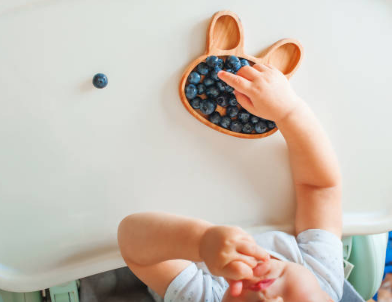It’s exciting to eat solid foods when your baby starts eating solid foods…… After all, babies are prone to obstruction of their airways and are new to the art of chewing and swallowing food, which makes them more susceptible to suffocation. (Not to mention all the non-food items that babies love to put in their mouths!)
Fortunately, babies are born with a strong gag reflex, which can be a good way to keep them safe. There are also many things parents can do to prevent choking. Here are some basic practices to help keep your baby safe.

Prepare Food Wisely
Cut food the right way. Always cut round foods such as olives, berries, cherry tomatoes, and grapes into half-moons or triangles, not wheels. For cylindrical foods, such as hot dogs and shredded cheese, short, thin strips are the safest. Overall, food chunks should not be larger than half an inch.
Serve soft, small portions. When your child starts eating solid foods, make sure their foods are soft and easy to break down. This means, starting with food that has been mashed, mashed, or filtered and has a very smooth texture.
Cook tough fruits and vegetables. Foods like apples and carrots are great for babies, but be sure to cook them so they can be easily mashed or pureed. Once your child is about a year old, feel free to grind hard fruits and vegetables.
Prepare the meat properly. Remove fat, skin and bones from poultry, meat and fish before cooking for your baby. Stir or cut into small slices along the meat pellets.
Establish Safe Eating Habits
Eat together. Eat at the same time as your child so you can demonstrate (and tell) safe eating strategies, such as chewing and swallowing before speaking and eating slowly.
Eat only at the table. If you only serve food at the table, you develop good table manners, and more importantly, you can minimize the risk of choking (such as eating while walking or running or lying down). When your child sits at the table, they should remain upright and alert.

Watch out for older kids. According to the American Academy of Pediatrics (AAP), many choking incidents occur when older children are fed dangerous foods (or dangerous toys) to younger children. This means, don’t let older kids feed babies!
Don’t Eat These Foods Before Age 4:
- Whole hot dogs and sausages
- Nuts and seeds
- Large pieces of meat
- Chunks of cheese and shredded cheese
- Uncut olives, grapes, cherries, melon balls, cherry tomatoes and berries
- raisin
- Popcorn, pretzels, and chips
- Chunks or a spoonful of nut and seed butter, such as peanut butter
- Large, hard pieces of raw fruits and vegetables
- Hard candy or sticky candy
- chewing gum
- Gummies, including vitamin gummies
- candy floss
Make Sure Your Home Is Free from Choking Hazards
One of the ways to prevent baby choking is to sweep the floor and play area every day to see if there are any small objects that your baby may pick up. And put it in their mouths. Xi such as vacuuming, picking things up regularly, and keeping change in a coin jar away from your baby can go a long way toward keeping your baby safe.

Also, keep your baby away from these high-risk choking hazards:
- Toys with widgets (always follow age guidelines)
- Toys that can fit completely into your child’s mouth, such as marbles
- Broken or loose toys
- Latex balloons
- coins
- button
- Small bows, hairpins, rubber bands
- Pen cap or marker cap
- Coin cell batteries (e.g. watch batteries)
- Fridge magnets
- Hard pet food
Learn to Recognize Choking
According to the AAP, if your child has trouble breathing, but can talk, cry strongly, or have difficulty breathing and cough violently, do nothing! If you have any of the following symptoms, have someone call 911 right away while helping your child:
- The complexion is bluish
- Inability to cry or make too many sounds
- Cough is weak and ineffective
- Make a soft or high-pitched sound when you inhale
- Difficulty breathing (ribs and chest pulled inward)
- Loss of consciousness
Know How to Help
If your baby doesn’t cough violently or cry loudly, place your baby face down on your forearm and use your lap for support. Support the baby’s chest with your hands and your fingers around the baby’s chin. Have your baby’s head down, lower than their body, and tap five times quickly and firmly between their shoulder blades.
If the object still doesn’t come out after five taps, turn your baby over, face up, still on his knees as support. Support your baby’s head and place two fingers in the middle of the sternum just below the nipple. Push down quickly up to five times, compressing the chest to a depth of one-third to one-half of the chest.
Next, perform five back blows, followed by five chest blows, until the object is removed. If your child is unresponsive, stops breathing, or turns blue, perform CPR. Or, if you can see an object blocking your child’s airway, try removing it with your fingers.
